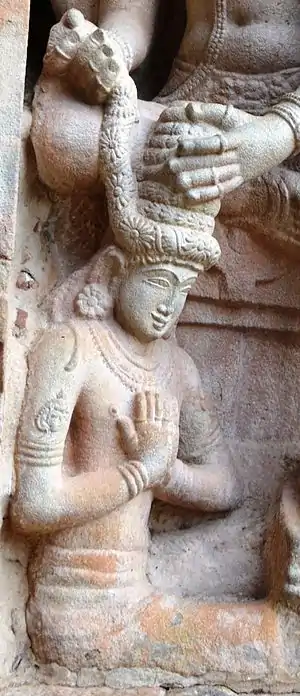1017
Year 1017 (MXVII) was a common year starting on Tuesday (link will display the full calendar) of the Julian calendar.
| Millennium: | 2nd millennium |
|---|---|
| Centuries: | |
| Decades: | |
| Years: |
| 1017 by topic |
|---|
| Leaders |
|
| Birth and death categories |
| Births – Deaths |
| Establishments and disestablishments categories |
| Establishments – Disestablishments |
| Gregorian calendar | 1017 MXVII |
| Ab urbe condita | 1770 |
| Armenian calendar | 466 ԹՎ ՆԿԶ |
| Assyrian calendar | 5767 |
| Balinese saka calendar | 938–939 |
| Bengali calendar | 424 |
| Berber calendar | 1967 |
| English Regnal year | N/A |
| Buddhist calendar | 1561 |
| Burmese calendar | 379 |
| Byzantine calendar | 6525–6526 |
| Chinese calendar | 丙辰年 (Fire Dragon) 3713 or 3653 — to — 丁巳年 (Fire Snake) 3714 or 3654 |
| Coptic calendar | 733–734 |
| Discordian calendar | 2183 |
| Ethiopian calendar | 1009–1010 |
| Hebrew calendar | 4777–4778 |
| Hindu calendars | |
| - Vikram Samvat | 1073–1074 |
| - Shaka Samvat | 938–939 |
| - Kali Yuga | 4117–4118 |
| Holocene calendar | 11017 |
| Igbo calendar | 17–18 |
| Iranian calendar | 395–396 |
| Islamic calendar | 407–408 |
| Japanese calendar | Chōwa 6 / Kannin 1 (寛仁元年) |
| Javanese calendar | 919–920 |
| Julian calendar | 1017 MXVII |
| Korean calendar | 3350 |
| Minguo calendar | 895 before ROC 民前895年 |
| Nanakshahi calendar | −451 |
| Seleucid era | 1328/1329 AG |
| Thai solar calendar | 1559–1560 |
| Tibetan calendar | 阳火龙年 (male Fire-Dragon) 1143 or 762 or −10 — to — 阴火蛇年 (female Fire-Snake) 1144 or 763 or −9 |

Sculpture of Rajendra I (r. 1014–1044)
Events
Europe
- Summer – Melus of Bari, a Lombard nobleman, revolts and is supported by Norman mercenaries at Capua. He marches into Apulia to catch the Byzantine army off-guard. Melus defeats the Byzantines on the banks of the Fortore River and ravages the territory in Apulia.
- Winter – Emperor Basil II ("the Bulgar Slayer") replaces Leo Tornikios with the new catapan Basil Boioannes and sends him reinforcements (including a detachment of the elite Varangian Guard) from Constantinople.
England
- January 6 – Cnut ("the Great") is crowned king of England. In July he marries Emma of Normandy, the widow of Æthelred the Unready, securing his ties with Normandy.[1]
- Cnut divides England into four earldoms: Wessex, Mercia, East Anglia and Northumbria.[1]
Arabian Empire
Africa
Asia
- March – Fujiwara no Michinaga passes the title of regent of Japan (Sesshō) to his eldest son Fujiwara no Yorimichi.
- September
- Prince Atsuakira of Japan, eldest son of ex-Emperor Sanjō, having been struck by a skin disease and under intense pressure from Michinaga, resigns the title of Crown Prince in favour of his younger brother, Prince Atsunaga[3] who marries Fujiwara no Kanshi, daughter of Michinaga.
- Michinaga makes a pilgrimage to the Iwashimizu Shrine in Japan accompanied by many courtiers. The travelers divide themselves amongst 15 boats for a floating trip down the Yotogawa River. One of the vessels overturns and more than 30 people lose their lives.[3]
- December 24 – Michinaga is granted the honorary title Daijō-daijin of Japan.
- Rajendra I, ruler of the Chola dynasty (in modern India), conquers Sri Lanka and annexes the island.[4]
Religion
- Construction of Saint Sophia Cathedral, Kyiv is started (approximate date).
Births
- October 28 – Henry III, Holy Roman Emperor (d. 1056) [5]
- Ahimaaz ben Paltiel, Italian-Jewish liturgical poet (d. 1060)
- Bermudo III (or Vermudo), king of León (approximate date)
- Floris I, count of Friesland west of the Vlie (approximate date)
- Ramanuja, Indian Sri Vaishnavism philosopher (d. 1137)
- Vikramabahu (Kassapa VI), king of Sri Lanka (d. 1041)
- Zhou Dunyi, Chinese philosopher and cosmologist (d. 1073)
Deaths
- February 5 – Sancho García, count of Castile
- June 5 – Sanjō, ex-emperor of Japan (b. 976)
- June 22 – Leo Passianos, Byzantine general
- July 6 – Genshin, Japanese Tendai scholar (b. 942)
- September 18 – Henry of Schweinfurt, German nobleman
- October 6 – Wang Dan, Chinese Grand Chancellor
- Eadric Streona, ealdorman of Mercia
- Eadwig Ætheling, son of Æthelred II
- Elvira of Castile, queen consort of León
- Emnilda, duchess consort of Poland
- Fujiwara no Junshi, Japanese empress (b. 957)
- Judith of Brittany, duchess of Normandy (b. 982)
- Ma'mun II, Ma'munid ruler of Khwarezm
- Ramon Borrell, count of Barcelona (b. 972)
- Renaud of Vendôme, French nobleman
References
- Palmer, Alan; Veronica (1992). Chronology of British History. London: Century Ltd; Barrie & Jenkins. pp. 48–49. ISBN 978-0712656160.
- Meynier 2010.
- Titsingh, Isaac (1834). Nihon Odai Ichiran, ou, Annales des empereurs du Japon. Paris: Royal Asiatic Society, Oriental Translation Fund of Great Britain and Ireland. pp. 156–7. OCLC 5850691.
- Agnihotri 2010.
- "Henry III - Holy Roman emperor". Encyclopedia Britannica. Retrieved April 17, 2018.
Sources
- Agnihotri, V. K. (2010). "South India". Indian History with Objective Questions and Historical Maps (26 ed.). Allied Publishers. p. 59. ISBN 978-8184243406.
- Meynier, Gilbert (2010). L'Algérie cœur du Maghreb classique. De l'ouverture islamo-arabe au repli (658-1518) (in French). Paris: La Découverte. ISBN 978-2707152312.
This article is issued from Wikipedia. The text is licensed under Creative Commons - Attribution - Sharealike. Additional terms may apply for the media files.